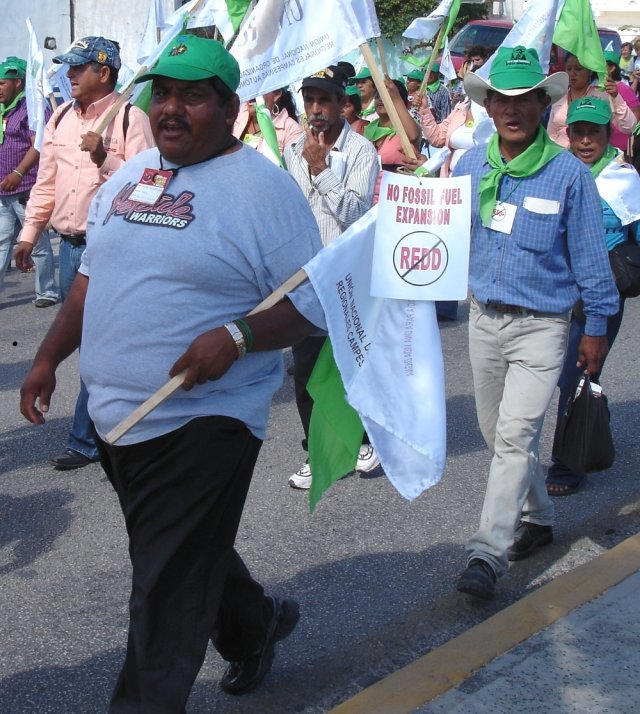
A new manual by six Europe-based NGOs calls for an end to forest offsets, whereby carbon emissions in one country can be supposedly “offset” by protecting forests in another.
Forest offset programs are largely organised through the Reducing Emissions from Deforestation and Forest Degradation (REDD) mechanism, which receives support from the World Bank and other financial institutions.
The report says there are two motivations for forest offsets: “reducing the pressure to do something about fossil fuel emissions and the short term profit motive.”
The manual was produced by Amis de la Terre (France), Arbeitsgemeinschaft Regenwald und Artenschutz (Germany), Euronatura (Portugal), Norges Naturvernforbund (Norway), Rainforest Foundation UK and FERN (Belgium).
The manual starts with a brief history of carbon trading. The idea of a market in pollution came from Ronald Coase, an economist at the University of Chicago, in the late 1960s. His theory sounds very familiar today.
As Larry Lohmann explains in his 2006 book Carbon Trading, Coase believed industry had a right to pollute, just like it had a right to use land.
Pollution should, therefore, be considered a commodity, just like the other commodities created from land, water, forests, labour and so on.
Later work, including by economists John Dales and Thomas Crocker, modified pollution trading theory by suggesting governments should set a cap on overall pollution levels, rather than leaving the amount of pollution to an imaginary “perfect market”.
But in a 2009 interview with the Wall Street Journal, Crocker was critical of the idea of cap and trade. “I’m skeptical that cap-and-trade is the most effective way to go about regulating carbon,” he said.
Dales has also spoken against using cap and trade to address climate change. In an interview in 2001, he said: “It isn’t a cure-all for everything. There are lots of situations that don’t apply.”
The 1997 Kyoto Protocol established the first compliance carbon market (as opposed to the voluntary markets, which include no legal obligation to reduce emissions). Carbon offsets were included — thus allowing companies and countries to finance projects aimed at reducing emissions in countries without emissions caps.
The manual notes that: “Carbon offsetting doesn’t intend to reduce emissions. Even in a best case scenario it is intended to move emissions from one place to another.”
REDD as a carbon trading mechanism is, of course, another carbon offset scheme. As such it will not reduce greenhouse gas emissions.
The next problem dealt with in the manual is that comparing the carbon stored in fossil fuels to the carbon stored in trees is like “comparing apples with pears”.
Fossil fuels are stable and emit carbon to the atmosphere only if they are dug out and burned. The way to address climate change is to leave fossil fuels in the ground.
Two papers published in Nature in 2009 calculated how much we should leave in the ground if we are to stand a chance of avoiding runaway climate change.
Trees, on the other hand, store carbon for a relatively short period.
While trees grow they absorb carbon, but this is always eventually released to the atmosphere. Trees die and decay. They can be attacked by pests. During heat waves (such as those that hit the Amazon in 2005 and again in 2010) they can go up in smoke.
With climate change, forests could even change from carbon sinks to carbon sources.

The authors of the manual sum up the problem as follows: “The reasons to halt deforestation are clear, it would safeguard the livelihoods of communities that depend on these forests, protect biodiversity and help stabilise the climate, but halting deforestation instead of drastically reducing emissions from fossil fuels, would simply not work.
“Temperatures will still rise, which could ultimately spell the end for many forests … That is one of the key reasons that forest carbon offsets are a false solution — they advocate reducing emissions from deforestation instead of reducing fossil fuel emissions, whereas both types of emissions need to be reduced.”
Having pointed out the fundamental problems with forest offsets, the manual outlines how the REDD negotiations have gone wrong.
In 2008 in Accra, India and China successfully lobbied for tree plantations to be eligible for REDD funds. Both countries have little remaining primary forests, but large areas of monoculture tree plantations.
Meanwhile, the Congo Basin countries have large areas of forests that they want to continue logging, so they said “sustainable management of forests” (including industrial logging) should be included in REDD.
The manual is critical of the Forest Stewardship Council’s certification of logging in primary forests: “[H]aving failed to ensure sustainable forest management is worth the paper it is written on, the FSC is now participating in side events during climate negotiations suggesting it can use its standards to complement those aiming to certify REDD+ carbon credits.”
The manual includes three brief case studies outlining the importance of indigenous peoples’ rights in Brazil, the problems of evictions to make way for carbon plantations in Uganda and the human rights abuses associated with the Guaraquecaba project in Brazil.
“Halting deforestation requires the change of our consumption pattern and the reduction of pressures driving forest destruction,” the authors write. “[T]here are no shortcuts”, to addressing climate change they note and add that business as usual is not an option.
The manual ends with some “starting points” for addressing climate change:
Shift subsidies away from fossil fuels;
Support existing positive initiatives and legislation such as feed-in-tariff schemes;
Shift electricity metering so tariffs increase rather than decrease with increasing usage;
Public investment in structural change;
Work with fossil fuel industries to start transitioning jobs away from the fossil fuel economy into the green economy;
Shift taxation so that carbon intensive activities are taxed as close to the source of the carbon emissions as possible.
[Reprinted from www.REDD-Monitor.org . Full Disclosure: REDD-Monitor has received funding from some of the organisations that wrote this manual.]